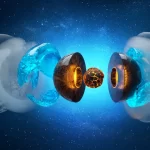Key Takeaways:
- Rare Phenomenon: Scientists aboard the International Space Station (ISS) observed a rare and captivating natural event – a ‘Blue Jet’ lightning bolt emerging from thunderclouds.
- Unique Perspective: Blue jets are typically challenging to witness from the ground due to their occurrence above thunderclouds, but the ISS provides a unique vantage point to capture these dazzling phenomena.
- Date and Location: The sighting occurred on February 26, 2019, near Nauru, a small island in the central Pacific Ocean.
- Scientific Observation: The event was documented in a report published in the journal Nature, shedding light on the elusive properties of blue jets.
- Elves in the Sky: The researchers also noted the presence of “elves,” another atmospheric phenomenon involving rapidly expanding rings of light in the ionosphere, during the event.
In a remarkable celestial spectacle, scientists aboard the International Space Station (ISS) have had the extraordinary opportunity to witness a ‘Blue Jet‘ lightning bolt emanating from thunderclouds. This unique event unfolded on February 26, 2019, near Nauru, a remote island in the central Pacific Ocean. The ISS, hovering above the Earth’s surface, provided an unparalleled perspective to capture this captivating phenomenon.
While ‘Blue Jets’ are often elusive when viewed from the ground due to their origin at the tops of thunderclouds, space-based instruments allowed scientists to observe this dazzling display from above. The event has been meticulously detailed in a report published in the prestigious journal Nature, contributing significantly to our understanding of this mysterious natural phenomenon.
The observation began with the sighting of five intense flashes of blue light, each lasting between 10 to 20 milliseconds. Subsequently, the blue jet expanded into a narrow cone shape, reaching into the stratosphere, an atmospheric layer situated between approximately 6 to 31 miles (10 to 50 kilometers) above the Earth’s surface.
The scientific community believes that blue jets materialize when the positively charged upper region of a cloud interacts with the negatively charged boundary between the cloud and the surrounding air. This interaction triggers an “electric breakdown” where charges within the cloud briefly equalize, resulting in the release of static electricity and the creation of the blue jet. However, despite their mesmerizing nature, the characteristics and altitudes of blue jets remain inadequately understood, making this study a significant contribution to the field.
During this event, four of the preceding flashes were accompanied by a small pulse of ultraviolet light (UV), identified as “elves.” These phenomena occur in the ionosphere, a layer of charged particles that extends from approximately 35 miles to 620 miles (60 to 1,000 kilometers) above the Earth’s surface. ‘Elves’ manifest as rapidly expanding rings of light in response to radio waves propelling electrons through the ionosphere, causing them to collide with other charged particles and release energy in the form of light.
The scientists captured this celestial ballet, including the flashes, elves, and blue jet, utilizing the European Space Agency‘s Atmosphere-Space Interactions Monitor (ASIM). Astrid Orr, the physical sciences coordinator for human and robotic spaceflight with the European Space Agency (ESA), described the research as an impressive highlight of ASIM‘s observations above thunderstorms.
Furthermore, experts speculate that atmospheric phenomena such as blue jets could have implications for greenhouse gas concentrations, as they occur within the stratosphere, where the ozone layer resides. This intriguing discovery underscores the importance of continued research on Earth’s dynamic and ever-fascinating atmosphere.


